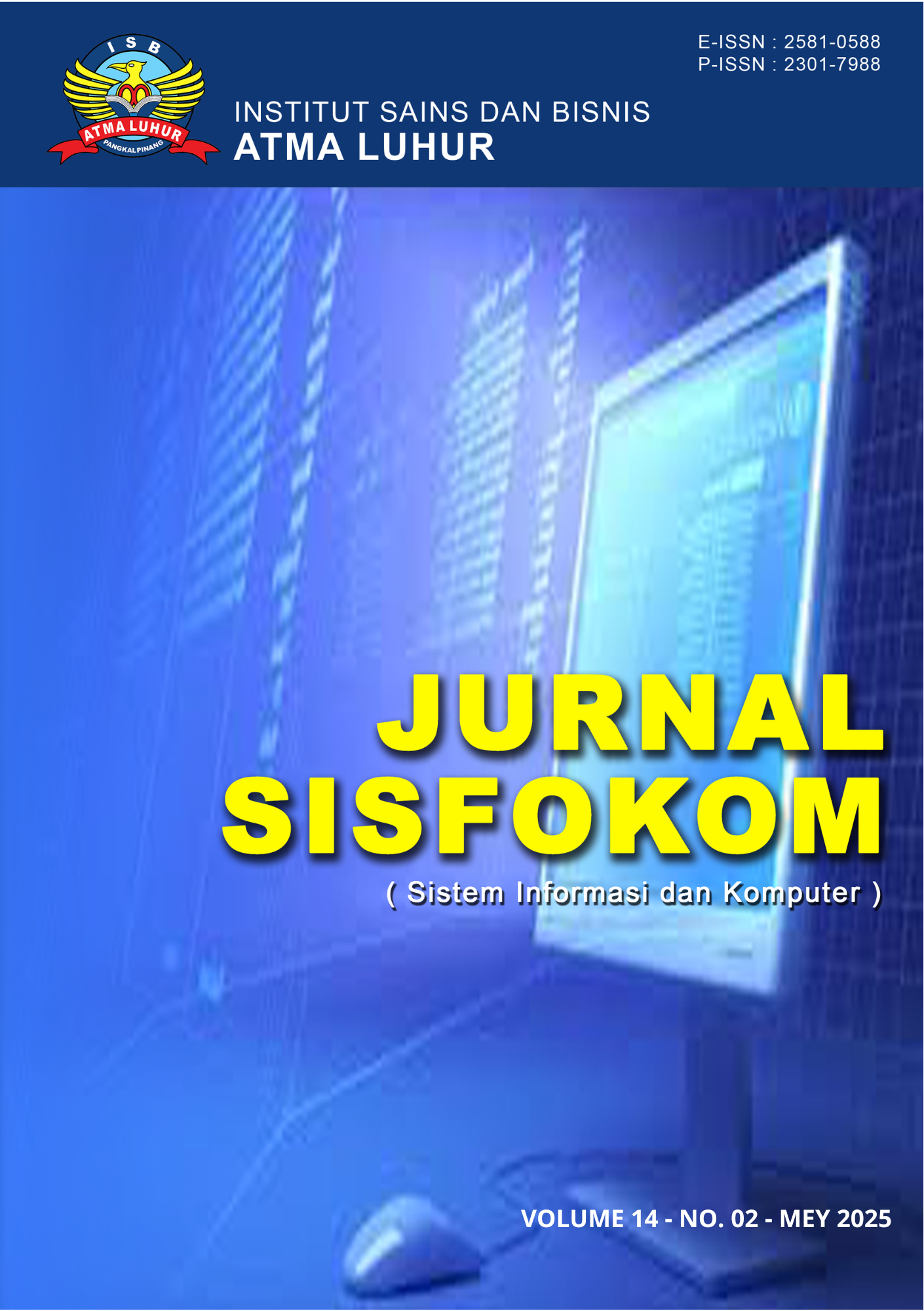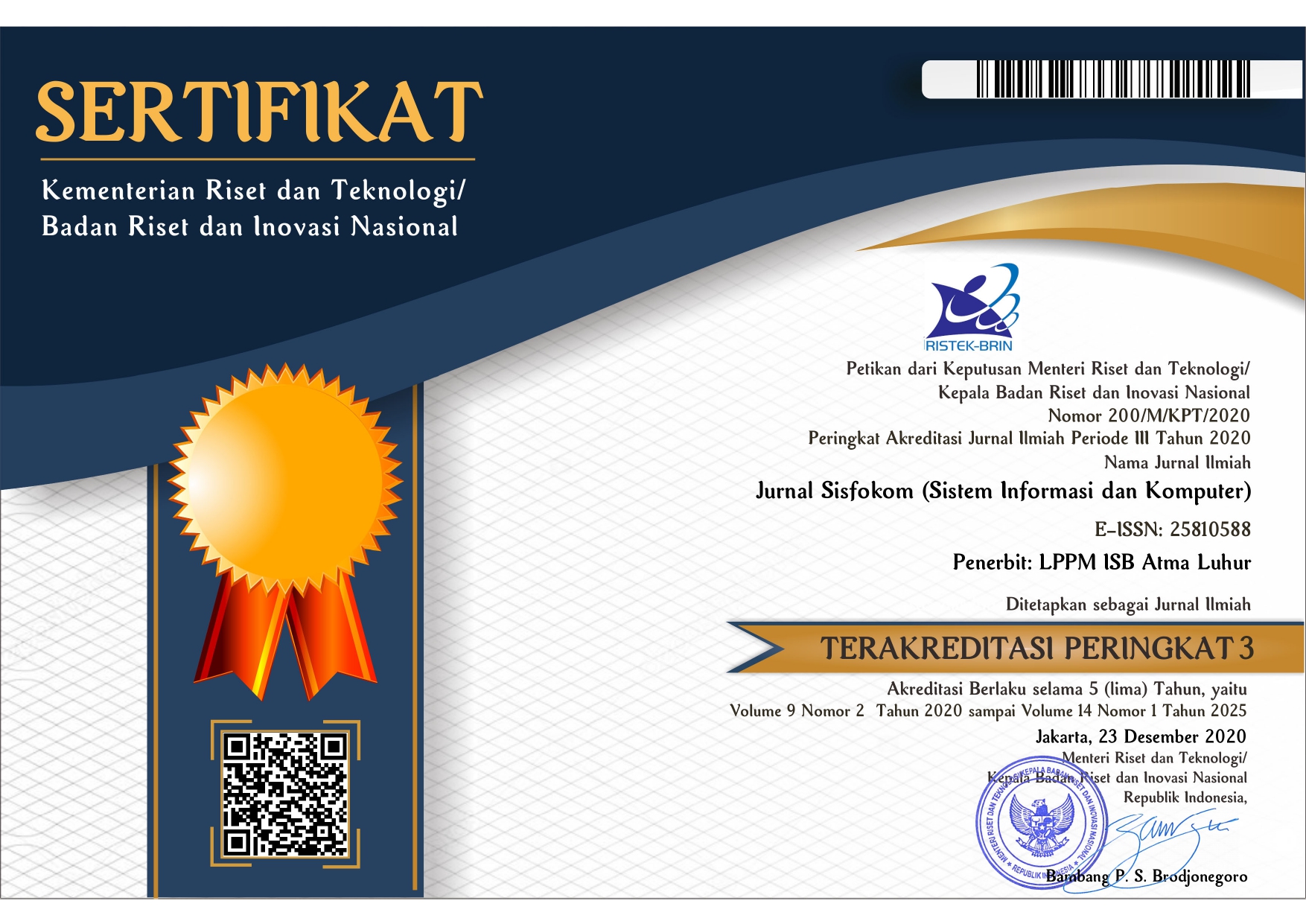Sentiment Classification of Public Perception on LHKPN Using SVM and Naive Bayes
DOI:
https://doi.org/10.32736/sisfokom.v14i2.2341Keywords:
Sentiment Analysis, Support Vector Machine, Naive Bayes, LHKPN, Social MediaAbstract
The public’s perception of the State Officials’ Wealth Report (LHKPN) serves as a vital measure of confidence in the government's commitment to transparency and efforts to combat corruption.This research seeks to examine public sentiment as reflected on the social media platform X. A dataset comprising 1,200 tweets was gathered and processed through various text mining methods, such as case folding, data cleaning, tokenization, normalization, stemming, stopword elimination, and TF-IDF vectorization. The tweets were then manually annotated into two sentiment categories: positive and negative, with 77.3% of tweets labeled as positive and 22.7% as negative. Sentiment classification was conducted using two machine learning algorithms: Support Vector Machine (SVM) and Naive Bayes. The Naive Bayes algorithm recorded an accuracy of 86.66%, with a precision of 0.93, a recall score of 0.88, and an F1-score of 0.87. Conversely, the SVM model with a linear kernel demonstrated superior performance, achieving an accuracy rate of 93.33%, along with a precision of 0.93, recall of 0.98, and an F1-score of 0.95. To uncover frequently occurring topics, WordCloud visualizations were generated. These revealed that positive tweets often included words such as ‘lapor’ and ‘transparan’, while negative ones were more likely to contain terms like ‘bohong’ and ‘korupsi’. These findings indicate that public sentiment toward the LHKPN initiative is largely favorable, despite persistent concerns surrounding integrity and trustworthiness in asset reporting. This study highlights the effectiveness of sentiment analysis in gauging public opinion and informing future policy improvements.References
R. Y. Oly Viana Agustine, Erlina Maria Christin Sinaga, “Politik Hukum Penguatan Kewenangan Komisi Pemberantasan Korupsi dalam Sistem Ketatanegaraan Legal Politics of the Strengthening of Authority in the Constitutional System,” Konstitusi, vol. 16, no. 2, pp. 314–338, 2019.
U. M. Sosiawan, “Peran Komisi Pemberantasan Korupsi (KPK) Dalam Pencegahan dan Pemberantasan Korupsi,” J. Penelit. Huk. Jure, vol. 19, no. 4, p. 517, 2019, doi: 10.30641/dejure.2019.v19.517-538.
R. Nooraeni, H. D. Sariyanti, A. F. F. Iskandar, S. F. Munawwaroh, S. Pertiwi, and Y. Ronaldias, “Analisis Sentimen Data Twitter Mengenai Isu RUU KPK Dengan Metode Support Vector Machine (SVM),” Paradig. - J. Komput. dan Inform., vol. 22, no. 1, pp. 55–60, 2020, doi: 10.31294/p.v22i1.6869.
B. Pamungkas, A. Syaifuddin, and M. Muslimin, “Analisis Sentimen Twitter MenggunakanMetode Support Vector Machine (SVM) padaKasus Benih Lobster 2020,” J. Informatics, Inf. Syst. Softw. Eng. Appl., vol. 3, no. 2, pp. 10–20, 2021.
O. Zoellanda A.Tane, K. Muslim Lhaksmana, and F. Nhita, “Analisis Sentimen pada Twitter Tentang Calon Presiden 2019 Menggunakan Metode SVM (Support Vector Machine),” eProceedings Eng., vol. 6, no. 2, pp. 9716–9725, 2019.
B. W. Sari and F. F. Haranto, “Implementasi Support Vector Machine Untuk Analisis Sentimen Pengguna Twitter Terhadap Pelayanan Telkom Dan Biznet,” J. Pilar Nusa Mandiri, vol. 15, no. 2, pp. 171–176, 2019, doi: 10.33480/pilar.v15i2.699.
A. Rosadi et al., “Analisis Sentimen Berdasarkanan Opini Pengguna pada Media Twitter Terhadap BPJS Menggunakan Metode Lexicon Based dan Naïve Bayes Classi er Twitter Text Mining,” vol. 20, pp. 39–52, 2021.
A. P. Giovani, A. Ardiansyah, T. Haryanti, L. Kurniawati, and W. Gata, “Analisis Sentimen Aplikasi Ruang Guru Di Twitter Menggunakan Algoritma Klasifikasi,” J. Teknoinfo, vol. 14, no. 2, p. 115, 2020, doi: 10.33365/jti.v14i2.679.
E. Putra Nuansa, “Analisis Sentimen Pengguna Twitter Terhadap Pemilihan Gubernur Dki Jakarta Dengan Metode Naïve Bayesian Classification Dan Support Vector Machine,” Inst. Teknol. Sepuluh Nop. Surabaya, pp. 1–101, 2017.
P. Simposium, N. Multidisiplin, and U. M. Tangerang, “Analisis Sentimen Kinerja Pemerintahan Menggunakan Algoritma,” vol. 4, pp. 114–121, 2022.
Downloads
Published
Issue
Section
License

This work is licensed under a Creative Commons Attribution 4.0 International License.
The copyright of the article that accepted for publication shall be assigned to Jurnal Sisfokom (Sistem Informasi dan Komputer) and LPPM ISB Atma Luhur as the publisher of the journal. Copyright includes the right to reproduce and deliver the article in all form and media, including reprints, photographs, microfilms, and any other similar reproductions, as well as translations.
Jurnal Sisfokom (Sistem Informasi dan Komputer), LPPM ISB Atma Luhur, and the Editors make every effort to ensure that no wrong or misleading data, opinions or statements be published in the journal. In any way, the contents of the articles and advertisements published in Jurnal Sisfokom (Sistem Informasi dan Komputer) are the sole and exclusive responsibility of their respective authors.
Jurnal Sisfokom (Sistem Informasi dan Komputer) has full publishing rights to the published articles. Authors are allowed to distribute articles that have been published by sharing the link or DOI of the article. Authors are allowed to use their articles for legal purposes deemed necessary without the written permission of the journal with the initial publication notification from the Jurnal Sisfokom (Sistem Informasi dan Komputer).
The Copyright Transfer Form can be downloaded [Copyright Transfer Form Jurnal Sisfokom (Sistem Informasi dan Komputer).
This agreement is to be signed by at least one of the authors who have obtained the assent of the co-author(s). After submission of this agreement signed by the corresponding author, changes of authorship or in the order of the authors listed will not be accepted. The copyright form should be signed originally, and send it to the Editorial in the form of scanned document to sisfokom@atmaluhur.ac.id.









